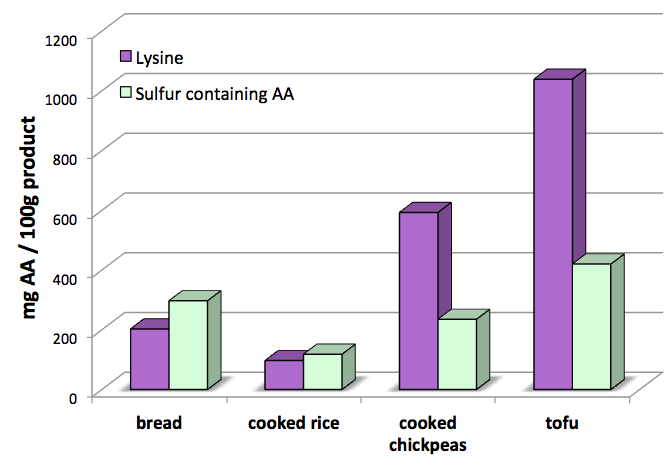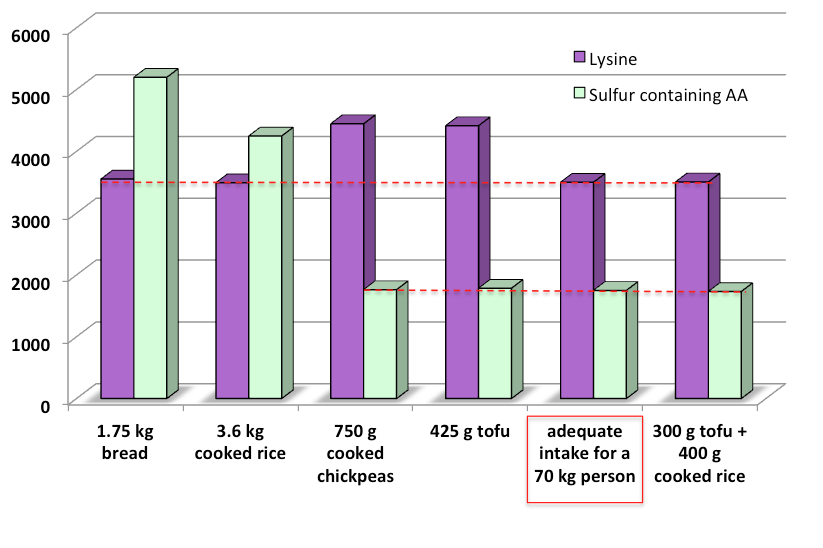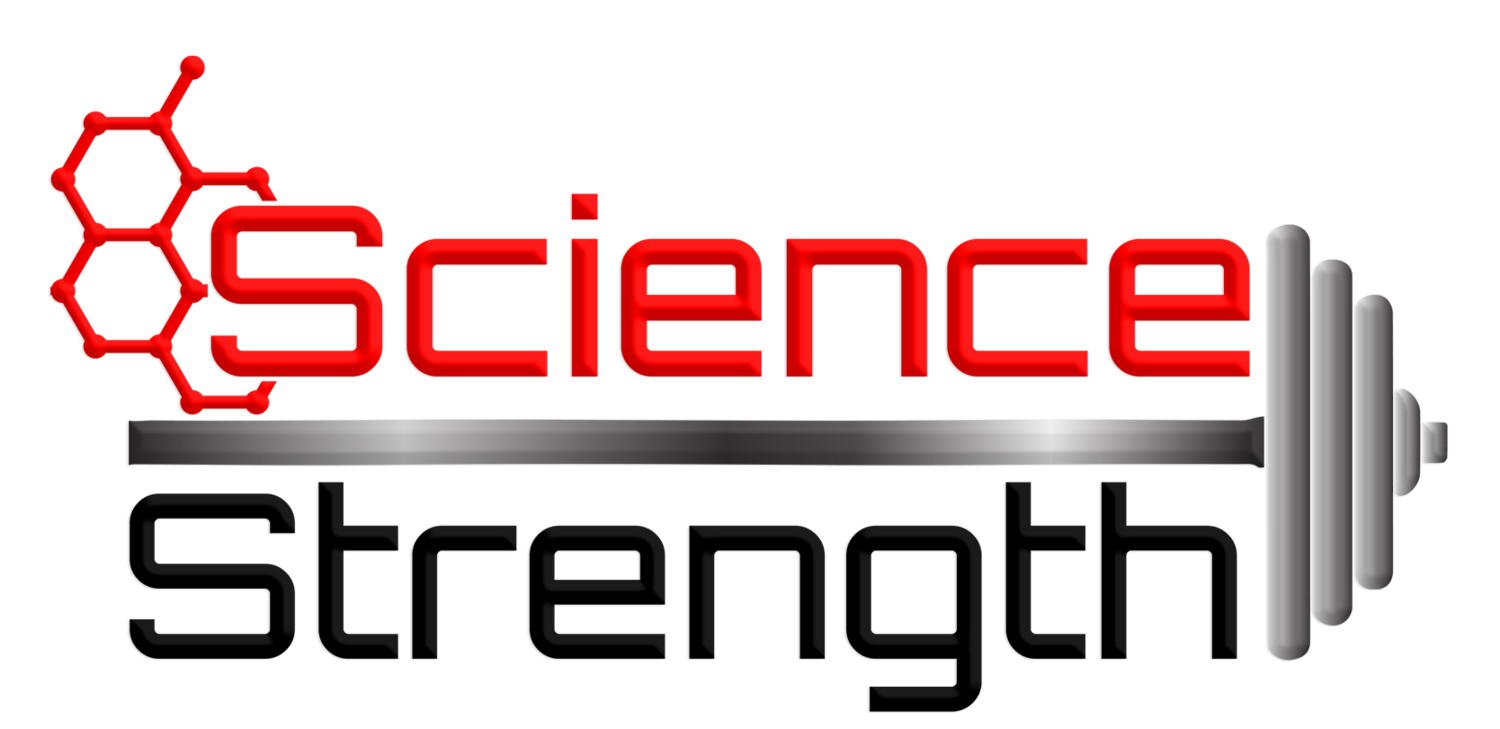Are you confused which plant protein sources to eat to get a complete amino acid profile? What is a complete amino acid composition? Isn’t it sufficient to eat ‘just enough’ protein?
Actually, we don’t need protein, what we need are particular amino acids. Although most recommendations speak about the protein requirement, the actual requirement is for amino acids, not for protein.1 Amino acids are building blocks for proteins. There are 20 different amino acids that are crucial for protein synthesis. You can imagine a protein as a long chain composed of different amino acids. All organisms - no matter if bacteria, plants or animals - contain proteins. Proteins have not only structural function (e.g. muscle), but also a variety of vital functions for all organisms. Enzymes, antibodies, ribosomes, all of these are proteins. The only difference between proteins found in different species is the amino acid composition, thus the ratio of individual amino acids. To apply the chain analogy: it means that all chains (proteins found in different species) contain all of the 20 different amino acids. However, not all chains have the same number of single amino acids.
Why is the amino acid composition important?
Humans cannot produce all of the 20 biologically important amino acids. Some of the amino acids, aka essential amino acids (EAA), we have to get from food. In general, most plant foods have a lower content of at least one of the essential amino acids compared to animal protein sources. This is the reason why plant protein is often considered to be incomplete. However, not all plant foods are low in the same essential amino acid. For instance, cereal grains are low in lysine, which is the limiting amino acid for many plant protein sources. On the contrary, legumes have significantly higher lysine content, but are lower in sulfur containing amino acids (Fig. 1). For this reason, it often is not enough just to get “only” enough protein, if the protein source is low in one of the essential amino acids.

Figure 1. Content (in milligrams) of essential amino acids lysine and sulfur containing amino acids per 100 g of the selected foods. Cereal grains have relatively high sulfur containing amino acid content compared to their lysine content. For legumes applies the opposite.
Although, it is in theory possible to obtain the recommended daily allowance on essential amino acid from one food source, in most cases an enormous food volume has to be consumed to hit the recommended target.2 For instance, for a 70 kg (154 lb) person it would require the consumption of 1.75 kg (3.85 lb) bread or 3.6 kg (7.92 lb) cooked rice to ensure an adequate intake of the limiting amino acid lysine (as shown in Figure 2). In this case, in order to obtain an adequate amount of the limiting amino acid, other amino acids are over consumed. As you can see in the Figure 2, sulfur-containing amino acids exceed the theoretical requirement (indicated by the red dashed line). For high carbohydrate fruit-based diets it is even more difficult to meet essential amino acid requirements. Let’s take bananas as an example. To reach the recommended lysine intake a daily consumption of 7 kg (15.4 lb) bananas is required. Getting enough of sulfur containing amino acids would require the consumption of 10 kg (22 lb) bananas a day! This huge food quantity is needed just to get the MINIMUM requirement of these essential amino acids. To what extent the human body can adapt to a very low essential amino acid diet is not entirely clear. However, I am very skeptical about the idea that most people (genetic freaks excluded) can thrive on such a diet.
Through a combination of different plant protein sources it is possible to meet the targeted daily allowance of essential amino acids and to obtain a more balanced amino acid distribution. An example for a suitable food combination is the ‘300 g tofu and 400 g rice’ meal shown in Figure 2. This food amount can be easily divided into 2 main meals and is sufficient to meet the requirement for a sedentary 70 kg person.

Figure 2. The amount of different foods necessary to meet the estimated daily requirement for a 70 kg (152 lb) person. The dashed red lines highlight the theoretically required amino acid quantity. The meal consisting of ‘300 g tofu and 400 g rice’ provides the required amino acid quantity in contrast to the same foods when consumed in isolation when not overconsumed.
Using only one protein source to meet essential amino acids requirement can have additional disadvantages. Overconsumption of a certain macronutrient is one of them. Just to give an example: the use of a high carbohydrate and lower protein source, such as bread, to meet essential amino acid requirements drastically increases the amount of carbohydrates in the diet. Getting most of the dietary protein from nuts would lead to very high fat content. Carbohydrate or fat overconsumption is likely to increase the energy intake above the required level and lead to undesired fat gain for most individuals.
If you need ideas how to combine food sources efficiently to get the desired macronutrient distribution following a balanced diet, check this out.
Even if a food source with a higher protein content, such as tofu is chosen, relying on it as a major protein source may have some disadvantages. Although legumes, such as soy, contain compounds that are in general associated with health benefits,3 eating too much of them can also cause micronutrient deficiencies (iron, zinc and calcium) with unbalanced nutrition or undernourishment.4
Do we really need to track all essential amino acids individually to prevent a possible deficiency?
No, not really, provided that a person eats enough protein. In this case, the recommended daily allowance (RDA) of 0.8 g/kg (0.36 g/lb) is definitely not enough. RDA was established using 2/3 animal products with a higher essential amino acid content compared to plant protein sources. Also, RDA characterizes the protein amount at which the risk of becoming protein deficient is very low (<3%) for most sedentary people (as I explain here). To put number on it (YES, I love numbers!), in theory, it is necessary to consume 16% more protein than RDA suggests for people following a well-balanced plant-based diet. This means that a 70 kg person needs to consume 65 g protein (not 56 g as RDA states) to meet the minimal (not optimal!) essential amino acid recommendation.
Take-home message
- Eat a variety of protein sources if you follow a plant-based diet, e.g. soy products, beans, lentils, grains, nuts and seeds. Supplement with plant-based protein powders if necessary.
- Eat at least 16% more protein than RDA recommends (for healthy individuals)
Side note
When it comes to muscle building, often the importance of leucine for muscle protein synthesis is emphasized (see my previous post). In this context it is important to note that leucine gives the signal for muscle protein synthesis, however, all amino acids (especially essential) are required as building blocks for muscle. For this reason, supplementation with leucine as the only amino acid is not likely to be a promising strategy.
Interested in vegan, high-protein, guilt-free treats? Get your free recipe ebook by subscribing to my list ;)
References
(1) Baechle, T. R.; Earle, R. W. Essentials of Strength Training and Conditioning; 2008.
(2) Young, V. R.; Pellett, P. L. Am. J. Clin. Nutr. 1994, 59, 1203S–1212S.
(3) Threapleton, D. E.; Greenwood, D. C.; Evans, C. E. L.; Cleghorn, C. L.; Nykjaer, C.; Woodhead, C.; Cade, J. E.; Gale, C. P.; Burley, V. J. BMJ 2013, 347, f6879.
(4) Schlemmer, U.; Frølich, W.; Prieto, R. M.; Grases, F. Mol. Nutr. Food Res. 2009, 53, S330–S375.
(5) Nutritional information take from: http://nutritiondata.self.com/
